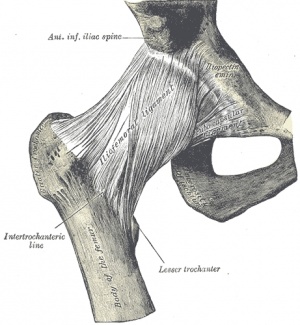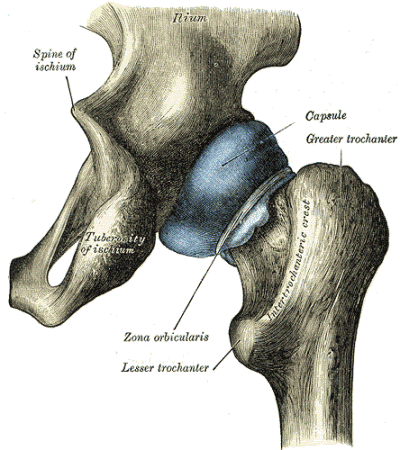Hip Anatomy: Difference between revisions
Aarti Sareen (talk | contribs) No edit summary |
No edit summary |
||
| Line 34: | Line 34: | ||
*The hip joint is extremely strong, due to its reinforcement by strong ligaments and musculatrue, providing a relatively stable joint. Unlike the weak articular capsule of the [[Glenohumeral Joint|shoulder]], the hip joint capsule is a substantial contributor to joint stability<ref>Levangie P, Norkin C. Joint structure and function: A comprehensive analysis. 4th ed. Philadelphia: The F.A. Davis Company; 2005.</ref>. The capsule is thicker anterosuperiorly where the predominant stresses of weight bearing occur, and is thinner posteroinferiorly.<br> | *The hip joint is extremely strong, due to its reinforcement by strong ligaments and musculatrue, providing a relatively stable joint. Unlike the weak articular capsule of the [[Glenohumeral Joint|shoulder]], the hip joint capsule is a substantial contributor to joint stability<ref>Levangie P, Norkin C. Joint structure and function: A comprehensive analysis. 4th ed. Philadelphia: The F.A. Davis Company; 2005.</ref>. The capsule is thicker anterosuperiorly where the predominant stresses of weight bearing occur, and is thinner posteroinferiorly.<br> | ||
[[Image: | [[Image:Capsule of hip.gif]] | ||
== Muscles == | == Muscles == | ||
| Line 80: | Line 80: | ||
*[http://www.rad.washington.edu/academics/academic-sections/msk/muscle-atlas/lower-body/piriformis Piriformis] | *[http://www.rad.washington.edu/academics/academic-sections/msk/muscle-atlas/lower-body/piriformis Piriformis] | ||
| {{#ev:youtube|dCrNgnLPDos}}<span style="line-height: 1.5em;"> </span> | ||
== Closed Packed Position == | == Closed Packed Position == | ||
Revision as of 10:38, 9 December 2013
Original Editor - Tyler Shultz
Top Contributors - Tyler Shultz, Admin, Kim Jackson, Aarti Sareen, Samuel Adedigba, Lucinda hampton, Laura Ritchie, Rachael Lowe, Scott Buxton, Leana Louw, Ahmed M Diab, Joao Costa, Ewa Jaraczewska, Evan Thomas, George Prudden, Priyanka Chugh, WikiSysop and Kirenga Bamurange Liliane
Description[edit | edit source]
The hip articulation is true diarthroidal ball and-socket style joint, formed from the head of the femur as it articulates with the acetabulum of the pelvis. This joint serves as the main connection between the lower extremity and the trunk, and typically works in a closed kinematic chain.
Motions Available[edit | edit source]
- Flexion: forward and upward movement of the femur at the hip occurs in the sagittal plane about an medial-lateral axis.
- Extension: upward movement toward the rear of the body of the femur at the hip occuring in the sagittal plane.
- Abduction: movement of the femur on the hip in a direction away from the midline of the body in the frontal plane.
- Adduction: movement of the femur on the hip in a direction toward the midline of the body in the frontal plane.
- Internal Rotation: rotation of the femur toward the midline of the body in the transverse plane.
- External Rotation: rotation of the femur away from the midline of the body in the transverse plane.
Ligaments & Joint Capsule
[edit | edit source]
- Ligamentum Teres[3]: This ligament is located entirely within the hip joint. It spans the hip running from the acetabular notch to the fovis capitis of the femur, attaching the femoral head to the inferior acetabular rim. This ligament is joined with nerves and vessels that pass to the femoral head. The vascular component of this structure is important during development, but is less significant in children. This ligament becomes taut during adduction, flexion, and external rotation, but only minimally contributes to joint stability.
- Ischiofemoral Ligament: Is the only ligament located on the posterior aspect of the hip. It attaches to the posterior surface of the acetabular rim and labrum. This ligament is said to "wind" around the joint and insert on the anterior aspect of the femur. The location and orientation of this ligament reinforces the joint capsule posteriorly and checks against excessive extension and internal rotation of the hip joint.
- Iliofemoral Ligament (Y Ligament of Bigelow): Attaches to the AIIS and then fans out to attach along the intertrochanteric line of the femur. The iliofemoral ligament is the strongest ligament in the body, and checks extension, adduction (superior fibers), and abduction (inferior fibers). In addition, because this ligament limits hip extension, it allows maintenance of the upright posture by reducing the need for muscle contractions.
- Pubofemoral Ligament: Is located on the anterior portion of the joint, arising from the anterior aspect of the pubic ramus and passing to the anterior surface of the intertrochanteric fossa. This ligament's main purpose is to check hip abduction and extension. This ligament may blend with the inferior fibers of the iliofemoral ligament.
Joint Capsule:
- The hip joint is extremely strong, due to its reinforcement by strong ligaments and musculatrue, providing a relatively stable joint. Unlike the weak articular capsule of the shoulder, the hip joint capsule is a substantial contributor to joint stability[4]. The capsule is thicker anterosuperiorly where the predominant stresses of weight bearing occur, and is thinner posteroinferiorly.
Muscles[edit | edit source]
Flexors:
Extensors:
Adductors:
Abductors:
Internal Rotators:
External Rotators:
- Gluteus Maximus
- Gemellus Superior
- Gemellus Inferior
- Obturator Externus
- Obturator Internus
- Quadratus Femoris
- Piriformis
Closed Packed Position[edit | edit source]
Full extension of the hip joint is the closed packed postion because this position draws the strong ligaments of the joint tight, resulting in stability.
Open Packed Position[edit | edit source]
The hip joint is one of the only joints where the position of optimal articular contact (combined flexion, abduction, and external rotation) is the open-packed, rather than closed packed position, since flexion and external rotation tend to uncoil the ligaments and make them slack[5].
Other Important Information[edit | edit source]
- Labrum[6]: The labrum forms a fibrocartilagenous extension of the bony acetabulum which increases the containment of the femoral head. In addition to this function, the labrum also obstructs fluid flow in and out of the joint through a sealing action which is often referred to as a “suction effect” in view of the resistance generated to distraction of the head from the acetabular socket. This sealing function not only enhances joint stability, but is thought to more uniformly distribute compressive loads applied to the articular surfaces, thereby reducing peak cartilage stresses during weight-bearing.
- Femoral Triangle: The femoral triangle is the region defined by the inguinal ligament superiorly, the adductor longus medially, and the sartorius laterally. This region is important because it contains numerous vascular and neural structures, including the femoral vein, artery, and nerve.
- Femoral Angle of Inclination: The angle of inclination is formed from the angle resulting from the intersection of a line down the long shaft of the femur and a line drawn threough the neck of the femur. Typically, the normal adult has an angle of inclination between 120 and 125 degrees, it usually is closer to 125 in the elderly. An increase in this angle, greater than 125 degrees, results in coxa valga, and a decrease is called coxa vara*.
- Femoral Angle of Torsion: The angle of torsion is formed by looking at the relationship between the axis of the femoral head and neck and the femoral condyles. The normal femur has an angle of torsion between 12 and 15 degrees. An increase in this angle is termed anteversion, while a decrease in this angle is termed retroversion*.
- It is important to note that both normal and abnormal angles of inclination and torsion are properties of the femur, and exist independently of the hip joint, however, abnormalities typically alter joint stability[7].
Resources[edit | edit source]
1. Dutton M. Orthopaedic: Examination, evaluation, and intervention. 2nd ed. New York: The McGraw-Hill Companies, Inc; 2008.
2. Levangie P, Norkin C. Joint structure and function: A comprehensive analysis. 4th ed. Philadelphia: The F.A. Davis Company; 2005.
Recent Related Research (from Pubmed)[edit | edit source]
Failed to load RSS feed from http://eutils.ncbi.nlm.nih.gov/entrez/eutils/erss.cgi?rss_guid=1jmC0p0kwOiCcpHKWOmjMllCc7HlEumcgsxa7rPPqN4vD1R5Z|charset=UTF-8|short|max=10: Error parsing XML for RSS
References[edit | edit source]
- ↑ Dutton M. Orthopaedic: Examination, evaluation, and intervention. 2nd ed. New York: The McGraw-Hill Companies, Inc; 2008.
- ↑ Levangie P, Norkin C. Joint structure and function: A comprehensive analysis. 4th ed. Philadelphia: The F.A. Davis Company; 2005.
- ↑ Anerson L. The anatomy and biomechanics of the hip joint. J Back Musculoskeletal Rehabil. 1994;4(15):145-153.
- ↑ Levangie P, Norkin C. Joint structure and function: A comprehensive analysis. 4th ed. Philadelphia: The F.A. Davis Company; 2005.
- ↑ Levangie P, Norkin C. Joint structure and function: A comprehensive analysis. 4th ed. Philadelphia: The F.A. Davis Company; 2005.fckLRfckLR
- ↑ Crawford M, Dy C, Alexander J, et al. The 2007 Frank Stinchfield Award. The Biomechanics of the hip labrum and teh stability of the hip. Clinical Orthopaedics and Related Research. 2007;465:16-22.
- ↑ Levangie P, Norkin C. Joint structure and function: A comprehensive analysis. 4th ed. Philadelphia: The F.A. Davis Company; 2005.








